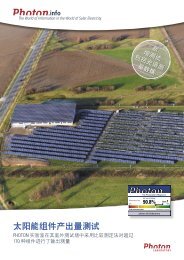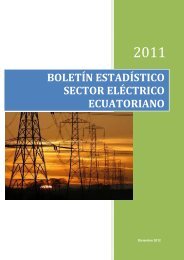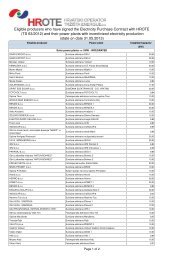INTRODUCTORY SPECIAL INTRODUCTORY ... - PHOTON Info
INTRODUCTORY SPECIAL INTRODUCTORY ... - PHOTON Info
INTRODUCTORY SPECIAL INTRODUCTORY ... - PHOTON Info
You also want an ePaper? Increase the reach of your titles
YUMPU automatically turns print PDFs into web optimized ePapers that Google loves.
State<br />
32<br />
Politics<br />
invest. If history is any guide, electricity<br />
prices will likely rise: since 2001, electric-<br />
ity prices in the US have soared, though<br />
it is difficult to estimate what the future<br />
rate of increase will be, especially in the<br />
midst of an economic downturn. States<br />
with a heavily coal-based electricity mix<br />
tend to have had low inflation rates his-<br />
torically, while states using more natural<br />
gas have seen greater price increases. In<br />
our return calculations, we assumed that<br />
electricity prices will increase by 3 per-<br />
cent annually. Note: if prices rise more<br />
quickly, your return could be higher.<br />
In addition to price inflation, there are<br />
other ways to artificially increase electric-<br />
ity prices, and thereby make solar a more<br />
attractive investment. One strategy is for<br />
the utility to implement tiered electric<br />
price structures. Under price tiering, the<br />
more electricity a homeowner consumes,<br />
the more he pays per kWh – a structure<br />
Solar incentives in 13 states<br />
Arizona<br />
California<br />
Colorado<br />
Connecticut<br />
Delaware<br />
Hawaii<br />
Maryland<br />
State rebate<br />
Renewable energy<br />
credit market<br />
State tax credit<br />
Feed-in tariff<br />
Website for more<br />
information<br />
$<br />
$<br />
$ $<br />
$ $<br />
$ $<br />
Massachusetts $ $ $<br />
New Jersey<br />
New Mexico<br />
New York<br />
Pennsylvania<br />
Vermont<br />
$ $<br />
$<br />
$<br />
$ $<br />
$ $<br />
$ $ $<br />
www.azdor.gov/brochure/543.pdf<br />
www.cpuc.ca.gov/PUC/energy/solar<br />
www.csi-trigger.com/<br />
www.xcelenergy.com/Residential/RenewableEnergy/Solar_Rewards/Pages/<br />
home.aspx<br />
www.ctcleanenergy.com/YourHome/SolarRebates/RebateAmounts/tabid/77/<br />
Default.aspx<br />
www.dnrec.delaware.gov/energy/services/GreenEnergy/Pages/GreenEnergy<br />
DelmarvaPower.aspx<br />
hawaii.gov/dbedt/info/energy/renewable/solar<br />
www.state.hi.us/tax/announce/ann09-09.pdf<br />
energy.maryland.gov/incentives/residential/solargrants/index.asp<br />
www.masstech.org/solar/res2009.html<br />
www.massenergy.com/Solar.REC.Sale.html<br />
www.njcleanenergy.com/renewable-energy/programs/renewable-energyincentive-program<br />
www.emnrd.state.nm.us/ECMD/CleanEnergyTaxIncentives/solartaxcredit.htm<br />
www.pnm.com/customers/pv/program.htm<br />
www.powernaturally.org/Programs/Solar/incentives.asp<br />
www.depweb.state.pa.us/energindependent/cwp/view.asp?a=3&q=545926<br />
paaeps.com/credit/<br />
$ $ www.rerc-vt.org/incentives/forms.htm<br />
psb.vermont.gov/docketsandprojects/electric/7523<br />
In our examination of the 13 solar colonies, we encountered a mix of incentive programs, including cash rebates,<br />
tax credits, renewable energy credits, and a feed-in tariff.<br />
that helps to motivate energy conserva-<br />
tion. The first part, or tier, of a household’s<br />
consumption is priced at a low rate. When<br />
consumption exceeds a certain limit, the<br />
consumer will enter the next higher-<br />
priced tier and pay that higher price for<br />
any additional energy usage. Many utili-<br />
ties in the US have adopted tiered pricing.<br />
California’s investor-owned utilities have<br />
especially steep tiers: in PG&E’s five-tier<br />
rate structure for residential customers,<br />
the Tier 5 price of 44 cents per kWh is four<br />
times the Tier 1 rate of 11 cents per kWh.<br />
Tiered pricing is a good thing for PV<br />
system owners. A PV system offsets the<br />
most costly electricity consumed first<br />
through net metering, improving the<br />
economics of solar. If you are considering<br />
the purchase of a PV system, you should<br />
learn more about your utility’s electrici-<br />
ty price structure. If there is price tiering,<br />
and your monthly electricity consump-<br />
tion puts you in a higher tier, that could<br />
boost your return on investment.<br />
California’s investor-owned utilities –<br />
Pacific Gas & Electric, Southern California<br />
Edison, and San Diego Gas and Electric –<br />
have significant price differences between<br />
tiers, so the rate of return for a PV system<br />
will vary greatly depending on your tier. A<br />
PG&E customer in Tier 5 with a PV system<br />
would save a lot more money than a Tier<br />
2 customer on a per kWh basis because of<br />
this difference, and thus have a much bet-<br />
ter IRR. We provided separate IRR calcula-<br />
tions for these three utilities in California<br />
because their tiered rate structures differ<br />
significantly. Note that these calculations<br />
are based on an assumption that the cus-<br />
tomer is in Tier 4. If you live in California<br />
and your consumption puts you in a high-<br />
er or lower tier, your IRR could be signifi-<br />
cantly higher or lower, respectively.<br />
PV system owners can also benefit from<br />
utilities that have a time-of-use rate struc-<br />
ture, in which electricity prices are more<br />
expensive during periods of increased<br />
electricity demand. Such »peak« periods<br />
occur in the late afternoon in Arizona<br />
and California during the summer when<br />
air conditioning use is at its highest. Con-<br />
veniently, many PV systems produce the<br />
most solar electricity during this peak pe-<br />
riod, so homeowners can take advantage<br />
of the higher offset on their utility bill<br />
through net metering. In the eastern US,<br />
where humid summers can keep air con-<br />
ditioning units on all day, peak periods<br />
often stretch from 9 AM to 9 PM.<br />
There is yet another important vari-<br />
able that could impact electricity prices:<br />
the possibility of a carbon tax. If the US<br />
passes a carbon tax – and there are cur-<br />
rently proposals for one at the national<br />
level – prices in states with a heavily<br />
coal-based electricity mix could change<br />
significantly.<br />
Falling PV system prices could some-<br />
what increase the rate of return for hom-<br />
eowners in states with low electricity rates.<br />
But according to On-Grid’s Andy Black,<br />
many states have such low grid prices that<br />
the system price doesn’t matter. »Even<br />
if you gave the system away for free, the<br />
savings on the electric bill wouldn’t be<br />
November 2009

















